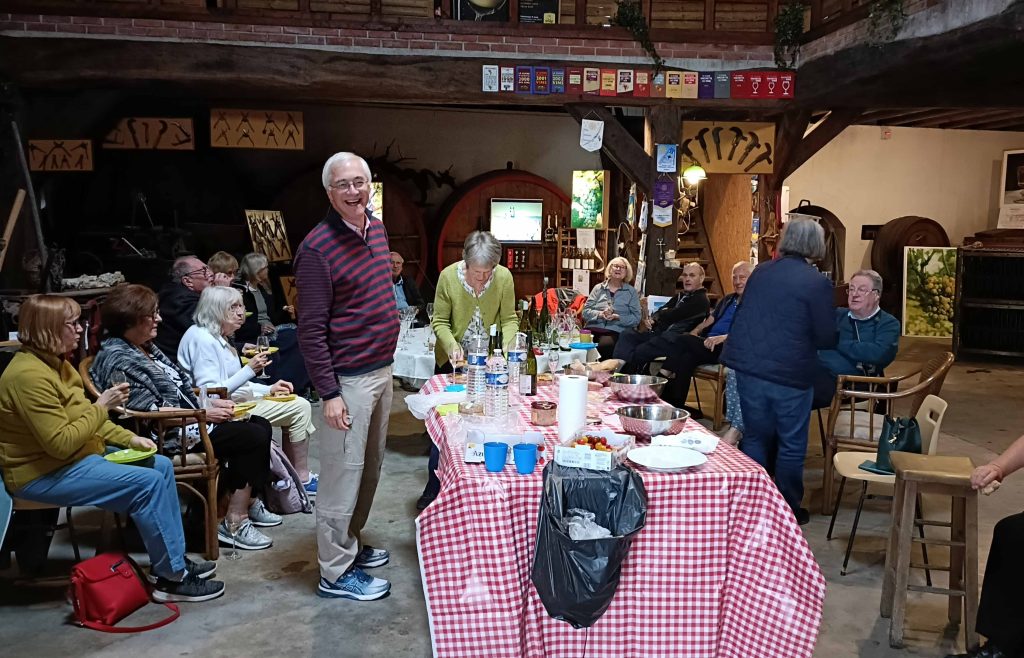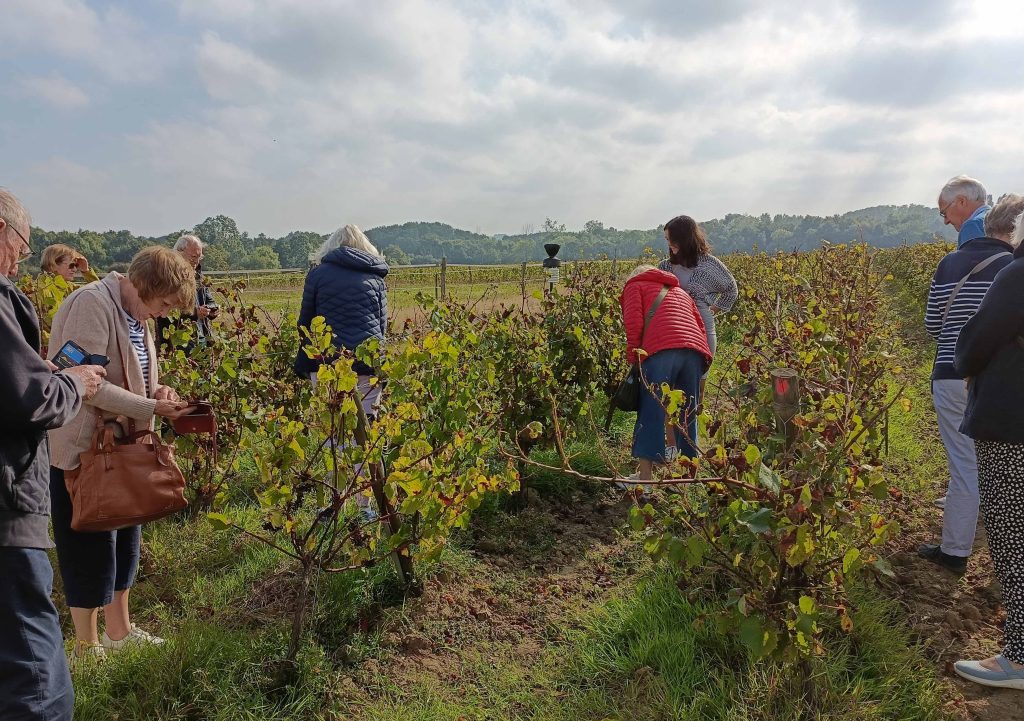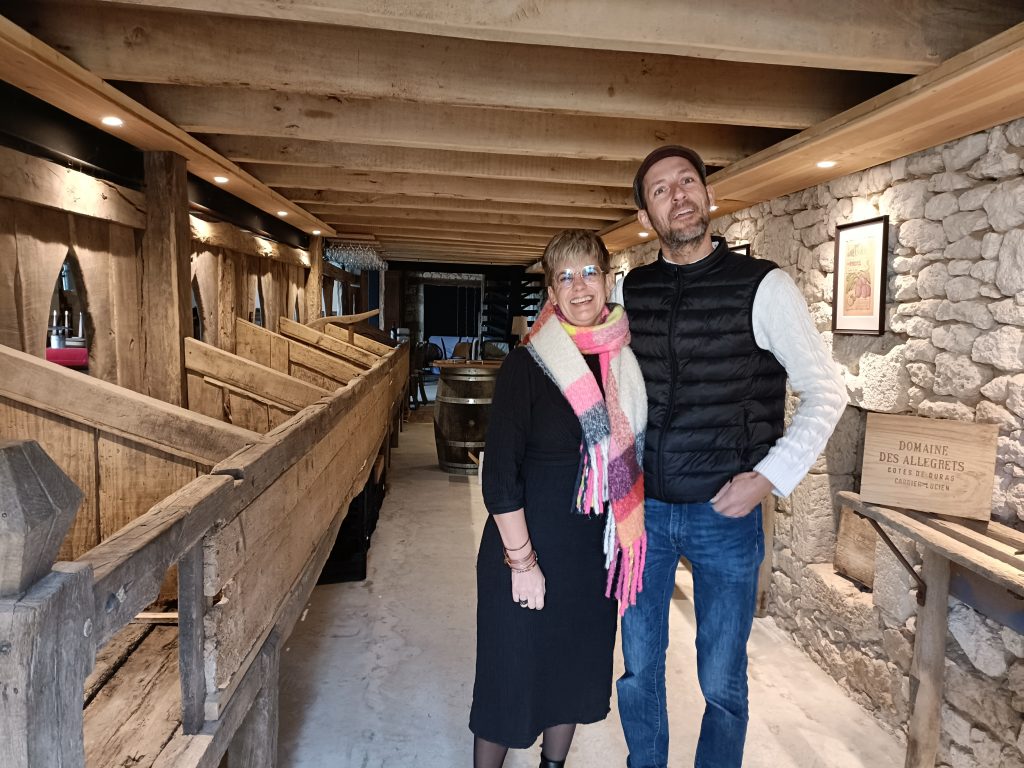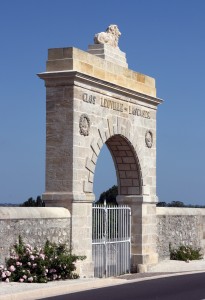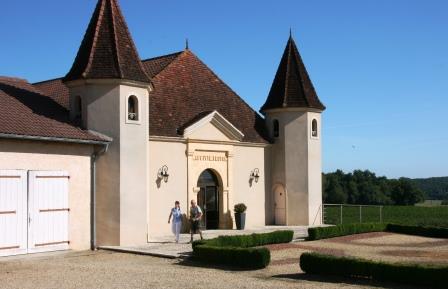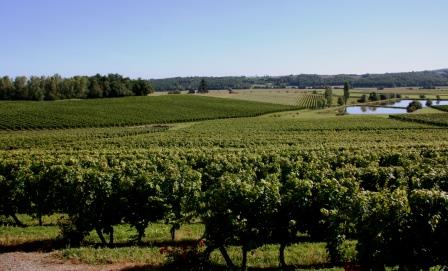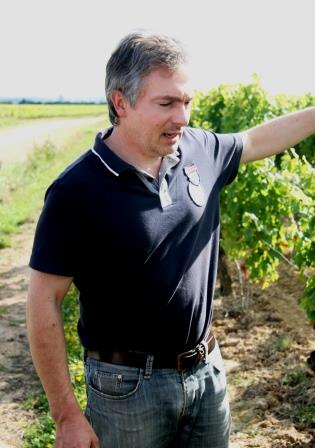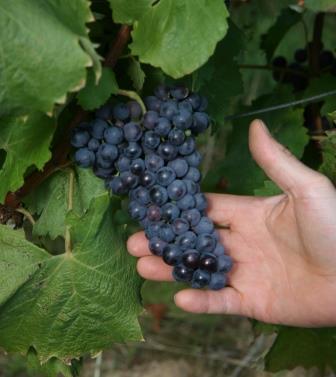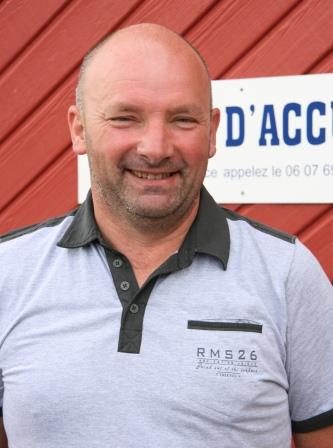 The first opportunity to lead a wine tour since Brexit gave me an invaluable opportunity to gain a fresh perspective on the high quality of winemaking and the deep challenges faced by so many Loire Valley vignerons. We made two visits in Anjou, five in Touraine and one in the Pays Nantais between 16th and 21st September.
The first opportunity to lead a wine tour since Brexit gave me an invaluable opportunity to gain a fresh perspective on the high quality of winemaking and the deep challenges faced by so many Loire Valley vignerons. We made two visits in Anjou, five in Touraine and one in the Pays Nantais between 16th and 21st September.
The first visit was to the Domaine Leduc-Frouin (‘La Seigneurie’) at Sousigné, so ably led by the brother and sister team of Antoine and Nathalie Leduc, whose stellar efforts had just been recognised in the 2025 edition of the Guide Hachette des Vins with the accolade of Loire Valley winemakers of the year.
The visit was only possible because cool weather the previous week delayed the start of harvest. They had hoped to begin around the 13th but weren’t able to begin until a week later. As we arrived their neighbours had just launched a picking machine in to the vines, the first in their sector to begin. Antoine and Nathalie pick all their 30 hectares by hand.
The Leduc-Frouin vineyards are on predominantly airy, well-drained sites with a mix of acidic soils (schist) and (alkaline) sedimentary limestone, overlooking the Valley of the Layon. Although some evidence of mildew was clear to see, losses here should not be significant. Maybe the choice of limited chemical intervention (certified Terra Vitis) rather than full-on organic viticulture has helped too?
Everything is well made, but two wines had particularly excited the Hachette panel, their benchmark (old vines) Rosé d’Anjou 2023, which is still wonderfully fresh, a miracle of balance, delicately perfumed red fruits, all rightly described as ‘quite simply perfect’ and the red, mostly Cabernet Franc, unoaked, Anjou Villages 2022, also grown on Schist, which helps to explain its soft but persistent acidity supported by ripe tannins and a lovely depth of ripe plummy, raspberry fruit. I also was greatly impressed by the unoaked Anjou Blanc 2023 (Chenin, of course) with its almost grapefruit freshness and then a magnificent unoaked Coteaux du Layon ‘Arpège’ 2021 (‘apreggio’ – such a lovely name for a wine!), which like all Antoine and Nathalie’s wines is all about the sheer beauty of top-quality fruit, handled with apparently infinite care, which in reality means a great deal of hard work.
Our second visit in this sector was to the Domaine du Portaille at Millé just a few kilometres to the west. It’s another family-fun estate, the work of brothers, Philippe and François Tisserond, still supported by their octogenarian father Marcel. It’s a slightly bigger estate, also affiliated to Terra Vitis, of some 50ha of vines, which they feel necessitates the use of machine harvesting in some sectors, though not, of course, for their excellent Crémant or magnificent sweet wines, crowned by a superb Bonnezeaux ‘Coteaux de Fesles’. This last wine in 2022, made from raisined (passerillé) grapes has quite extraordinary depth and power and yet retains a deliciously fresh focus right through the palate.
The consistently high quality across the range of wines is impressive, but for me the white wines stand out, both dry and sweet. The purity and focus of the unoaked dry Chenin Moulin de Millé is delightful, but the concentration and highly judicious aging in larger oak casks of the Coteaux de Millé 2022 is remarkable – a wine that gives every bit as much pleasure as a great white Côte d’Or Burgundy, but at a fraction of the cost. As a codicil to this tasting, I later opened a bottle of the 2008 Moulin de Millé, which though pale golden, was still fresh and lively, having gained a toasty complexity almost as if it were oaky. Might this be a function of its low pH rather like the similar toasty complexity acquired by tank-fermented and early-bottled old Hunter Valley Semillon?
Our visits in Touraine began at Berger Frères in Saint-Martin-le-Beau in the appellation of Montlouis-sur-Loire, grapes grown on limestone (tuffeau) and flinty soils. I have been a huge fan of this 15 ha. estate for many years, so ably run by Laurent Berger, who oversaw its conversion to organic viticulture in 2011. The next generation, Martin and Cyril now make the day to day decisions, but Laurent is still closely involved, always apparently closely followed by his little dog Kiki.
The biggest changes have been to concentrate increasingly on drier styles of wine and to experiment with a Méthode Ancestrale ‘Pétillant Naturel’ in addition to the traditional and, I think, hugely successful sparkling Montlouis-sur-Loire and Crémant de Loire wines produced here (the latter includes some Chardonnay). Méthode Ancestrale differs from traditional method fizz in that the wine undergoes a single fermentation, finished in bottle. Traditional method wine undergoes a second fermentation in the bottle. The former is bone dry and made here without the addition of sulphites.
I have to say that both styles are excellent, but I prefer (by a small margin) the traditional sparkling Montlouis-sur-Loire, with its fuller, richer fruit and subtle 6g/l dosage.
The estate makes two dry(ish) wines, both, as the appellation demands, from Chenin Blanc. Les Plants Baron 2020 is a marked by crip acidity and ripe apple flavours, while the Montée de Liards 2020 from vines planted in 1948 is more honeyed, with 24 g/l residual sugar and therefore technically demi-sec. It is also more persistent in the mouth with a very fine acidic focus. Most of our group preferred it. To finish, Laurent opened a Moelleux 2005 – a wine of sublime balance, all apple crumble and raisin, but not showing any signs of oxidation. It was perfection and evidence that even if they don’t sell as well as drier styles, the best sweeter wines from this appellation are truly one of its greater glories.
Losses here to mildew may be as much as 50%. It has been a hugely frustrating growing season and with more rain in the forecast hard to see how the harvest will have a wholly happy outcome.
Across the river in the much larger appellation of Vouvray, we enjoyed a remarkable tasting with Charles Lesaffre who bought his 30 ha. estate the Domaine des Aubuisières from Bernard Fouquet in 2021, a property including land once owned by his grandfather. If has been farmed organically since 2023. We were able to visit because harvest was not due to begin until 26 September – starting with grapes for the sparkling wines. The Bernard Fouquet label also includes some extremely well-made négoce wines, but we concentrated solely on the excellent estate wines.
Charles is clearly determined to make the best possible wines. He is keen to reduce sulphite levels, he favours balancing his wines’ naturally high acidity by often allowing malolactic conversion rather than the traditional local solution of retaining some residual sugar and in one of his first acts in 2021 he began to buy sandstone amphorae to age the wine. He also wants to experiment with aging the wine in granite and has already bought some large glass vessels. It is no accident that the symbol of the estate is a woodcock – a bird that is rare, unpredictable and tastes pretty wonderful (Charles insists!).
We began with two very fine sparkling wines (a significant percentage of the production as so often in Vouvray). Brut Fines Bulles from the 2022 harvest and aged 18 months in bottle, with a modest 4g/l dosage is fresh appley and gently autolytic (biscuity) – a very elegant style. Cuvée O, from the 2019 harvest, and zero dosage is, as one might expect, creamier and altogether more complex, with fine focus and balance, but inevitably a little less fruit.
Cuvée Silex, the biggest volume still dry white (though softened here in 2022 by 6-8g/l of sugar) is ripe, appley and surprisingly perfumed. Easy to enjoy, it has quite a long, minerally finish. Le Bouchet 2022 made with grapes from a site next to Huet’s fabled Clos du Bourg and with less than 1% residual sugar is vinified and aged in stainless steel with full malo-lactic conversion. Fatter and richer, the winemaking is a great success. Le Petit Clos 2022 was vinified and aged in amphorae. This time, the malo-lactic was blocked. It is both much more complex and also more mineral with an incredibly impressive acidic persistence in the mouth – a truly great wine. Le Marigny 2022 vinified and aged in oak barrels 20% of which were new was again made without undergoing a malolactic conversion. Ripe apple and oaky flavours are already well-integrated on the nose, but they still need a bit more time to come together in the mouth. For me, the star of this very fine trio is Le Petit Clos – a great vindication of Charles’s investment in amphorae.
Cuvée Gérald is named after Charles’s grandfather. The 2022 was picked on 1 October and has 24g of residual sugar. It lacks complexity, but in its more traditional style is deliciously fruity – apples again to the fore. Cuvée Saint Jean 2022 with grapes picked a fortnight later and 66g of sugar, and therefore moelleux, saw a year in oak and combines stone fruit (underripe white peach) with the ripe apple. A beautiful wine.
I last tasted wines here with Bernard Fouquet himself in 2017 (see Heather Doherty’s notes from that visit: https://wineeducators.com/the-versatility-of-chenin-blanc-bernard-fouquet-domaine-des-aubuisieres-vouvray-loire-valley/ ) . I was impressed then, but not as much as I am now.
In contrast, we headed east to the relatively new appellation (2011) of Touraine Chenonceaux to another estate run by a brother and sister, François and Maryline Desloges, the Domaine du Chapitre at Saint-Romain-sur-Cher. All their wines are impeccably well-made, with an impressive line-up from AOP Touraine as well as the stars of Touraine Chenonceaux, the latter grown on prize, south-facing sloping sites in the Cher Valley, with typically flinty soils. It is these that move me most, though a new fifty-fifty blend of Cabernet Franc and Côt ‘Confidence’ 2020 aged 15 months in small oak barrels was a revelation in its complex, ripe black-fruit complexity. The red (necessarily unoaked) Touraine Chenonceaux 2022, 60% Cabernet Franc and 40% Côt is quite rich, with spicy fruit and well-integrated tannins, but for me the top wine of the estate remains the white Touraine Chenonceaux. The 2022 is a glorious expression of Sauvignon Blanc, with its heady grapefruit and passion fruit aromas and just enough leesy complexity to give it real length.
In the classic red wine appellation of Saint Nicolas de Bourgeuil, Nathalie and David Drussé produce a benchmark range of unoaked styles that reflect the very different soils of the appellation, with a glance too into neighbouring Bourgeuil. They farm 22 ha, now certified organic. Ther range also includes a nicely made IGP Sauvignon Blanc and a joyously fruity, simple, short-maceration 2023 Cabernet Franc from sandy soils (a former asparagus farm), but the Saint Nicholas proper beings with ‘Les Gravières’ from a former bed of the Loire, which in 2023 is a bright, deliciously uncomplicated, crunchy raspberry red and then, next, a Vieilles Vignes 2022 (sixty-year-old vines) from limestone and clay soils at the top of the slope which shows altogether blacker, quite jammy fruit – rich in this warm year with ripe tannins and well-balanced acidity. And then from fruit picked 15 days later on the same site and given a whopping 45-day maceration, Amplitude 2022 has wonderful depth but still manges to finish fresh and lively – a magnificent St Nicholas de Bourgeuil.
Incidentally, David is hugely aware of the green tannic character of Cabernet Franc that may not have achieved full phenolic ripeness and now takes care to remove the pips from his grapes after crushing and before maceration. This extra effort seems to work well for him. The tannins in his wines are much less dominant and green than when I first tasted them fifteen or twenty years ago.
The evening before our visit I opened a range of older wines from the estate beginning with Vieilles Vignes 2015 which is now fully mature, with a hint of nettles on the aroma, fairly light and with rounded tannins. ‘Intuitive’ 2015, the predecessor of Amplitude, was altogether more intense with damson and intense black fruit, almost an imitation of Côt. It still has huge potential to age and improve. Vielles Vignes 2012 was simpler, but beautifully balanced, with sweet plummy fruit. The fruit in Les Gravières 2010 was beginning to dry out a little, but still fragrant, then the Bourgueil ‘Leroy de Restignié’ 2009 showed much more life, with sweetly ripe black fruit.
There’s more. At the start of our visit, David treated us to two older vintages still, both of Les Gravières, aged in the tuffeau caves, former quarries that extend 500m under the hillside, which he shares with other growers. Both were remarkable: a 1999 still full of life and then a 1996, which though its tannins were a bit more grippy, was still a refreshing drink. The last was the first vintage he made, in those days, with drier tannins, higher acidity and a longer maceration. Tasted young, I quite imagine they were grippy, challenging mouthfuls. I don’t expect his very well-made more recent efforts will last anything like so long or as well as those wine certainly showed as perhaps our own little vertical tasting suggests, but what is also clear, however, from all this is that his considerable winemaking skills have developed quite impressively too.
We crossed the river to the excellent 18ha Domaine de Noblaie at Ligré in the appellation of Chinon, where wines of all three colours are made, including some unusual and quite remarkable white Chinon (Chenon Blanc). The grapes are grown organically. The range also includes an excellent Méthode Ancestrale fizz made from two-thirds Chenin and one third Cabernet Franc, the latter giving it a gentle golden hue as well as a clear hint of red fruits on the nose and palate. Chinon Rosé 2023 which induces a small proportion of Cabernet Sauvignon (originally planted here, as the rules for the appellation allow, to give the red wines a bit more colour). Made by direct pressing of the grapes it is fruity, dry and with more than hint of rhubarb. Nice! The first white Chinon, Chante le Vent 2022 is unoaked, from grapes grown on limestone soils. Really quite complex, it has fine mineral persistence and lingering citrussy acidity. La Part des Anges 2021 is from a single parcel of old sixty-year-old vines, given a full malo-lactic conversion, fermented and aged for 6 months in small oak barrels, but without lees stirring. It is, quite simple, magnificent, with a buttery richness that would be hugely confusing in a blind tasting and yet its appley fruit is untypical, say, of a fine white Burgundy – and, in fact, it is truly consistent with Chenin. A great wine, by any standards.
The red wines begin with the best-selling Le Temps de Cerise 2023, given just 7 to 10 days maceration. It’s lovely and light and with its cherry fruit, highly appropriately named, all supported by fresh acid and gentle tannins. It’s easy to see why it is so popular. Les Chiens chiens 2021 (no-one seems to know the strange origin of the name of the parcel) grown on clay-rich spoils on one of the highest parts of the estate and then aged 12 months in 500 litre oak casks is altogether more complex with spicy, intense raspberry fruit, real freshness, satisfyingly rounded mouth-feel, elegant tannins and a long savoury finish. On the day it showed even better than the magnificent Pierre de Tuf 2021 from eighty-year-old vines, which has a superb aroma of complex black fruit, especially black cherry and marked minerality, but in the mouth I feel it still needs time to knit together its firmer tannins with the fruit.
Finally we trekked west to Pays Nantais and the biodynamically-farmed Muscadet de Sèvre et Maine estate of Bonnet-Huteau at La Chapelle-Heulin which has 40 ha. Of vines. Harvest had begun (we were able to see it arrive at the press), but the vines around the winery were horribly devastated by mildew. The estate will have lost at least 60% of the crop, though they remain defiantly upbeat about the quality of the fruit they have been able to save.
Bonnet-Huteau has a lively policy of diversification, with plantings of Pinot Gris, Sauvignon Gris, Cabernet France, Côt (Malbec) and even Syrah and well as the once widespread Folle Blanche, all in addition to Melon, the sole ingredient of Muscadet. I asked to concentrate on Muscadet, but could not resist the opportunity to sample a Folle Blanche. The 2023 was floral, fresh and simple with typically high acid – and green apple fruit. It’s not a bad wine at all, far from it, but it’s easy to see why Folle Blanche is so often distilled.
Three Muscadets, each grown of a different soil type each aged 10 month on the lees to add complexity and texture were remarkably fine. Gautronnières 2023 grown on silty-clay above amphibolite and ‘green rock’ showed ripe apple flavours, almost like Chenin with a very creamy, leesy texture – lighter bodied, of course, than Chenin and with more linear acidity. Les Louvres grown on granite was said by one taster to have a whiff of coconut (I then found it too!) and even hints of stone fruit, typical softer acidity – a wine of great purity. Clos Moulin Chartrie grown on gneiss and some limestone – a shallow soil as for the previous wine – produced, in comparison, an explosion of ripe orchard fruits, crisper acidity and a very creamy, long finish – quite the most beguiling of the three.
Finally, Médolia 2020, 100% Melon, but marketed as Vin de France was aged 12 months in 700 litre clay eggs with no added sulphites. Quite pungent and slightly oxidative, it was savoury and long, but I feel, more a curiosity than a genuine step forward in quality. Nevertheless, if anyone ever doubted that Muscadet could be a truly fine wine, the previous three wines showed clear and hugely welcome evidence to the contrary.
Overall, despite the clear anxieties around the 2024 harvest and, it has to be said, the very challenging economic viability of sustaining such losses, we tasted some remarkable and very memorable wines, with the fresh acidity and relatively lean styles of the perhaps more classic 2021 and 2023 vintages contrasting with the richer riper fruit of 2022. It’s clear that wine styles are changing across many Loire appellations, with fewer sweet wines and a willingness to experiment with a far greater variety of winemaking techniques, but Loire Valley wines still firmly express their distinct identity and sense of place, or as the French say terroir perhaps, just maybe, even better than ever before. I am convinced and delighted by what we tasted. Standards are rising. Notwithstanding the trails of the growing season, the Loire is a place of joy.
